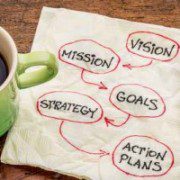Legal Business Development: Plans Are Important, But Nothing Happens Without Action!
It’s obvious that action is required to bring in new business, right? Sometimes, though, you have a great justification for not action… When everyone is out of town or busy, when you’d like to get started with networking, but no available group feels like a good fit, when you just don’t know where or how to get published or to get an opportunity to speak, what then?
Here’s the simple truth: you will hit roadblocks, quagmires of uncertainty or doubt, and even roadblocks in your business development journey.
A few of my clients have run into this situation, and their response often predicts (or even determines) their level of success. Those who move forward in a helpful direction, even if it isn’t optimal, tend to do well; those who stall out and wait for the “right” conditions tend to flail and eventually fail. The successful ones pursue a common line of analysis, and that’s what I’d like to share with you today.
Step one: determine whether this is an obstacle, meaning a temporary challenge that can be resolve through action or by the passage of time, or a roadblock, meaning a long-lasting challenge that is due to issues you don’t control. Imagine that you’ve identified an organization that sounds ideal for your practice. If it’s on hiatus for the summer, that’s just an obstacle. If your review of the events calendar shows that activity has dwindled to nothing and that the organization appears to be moribund, that may be a roadblock.
Solve or wait out obstacles; strategize an alternative approach to get around a roadblock. Continuing the organization example, if the group is on hiatus for the summer, you can simply wait for Fall to get involved, and perhaps you can consider helping the group find ways to stay active even over the summer. If the group is moribund, however, even though you could try to revive it, it probably wouldn’t be the best use of your resources, so you should look for another activity.
Step two: if you’re waiting out an obstacle, get started with something else in the meantime; if you’ve hit a roadblock, go to plan B. Could you identify some leaders in the group whom you might contact directly? Is there a next best organization you might join? You might choose instead to work on getting an article written and published, or you might track down a speaking opportunity that makes sense for your strategic plan.
There is always a viable Plan B. If you find that you’re tied to a single approach, pull out a piece of paper and brainstorm alternatives, giving yourself permission to list even the silliest ideas in service of finding the right idea.
Whether you adjust your plans to move around an obstacle or a roadblock, you must keep moving. Don’t allow an obstacle to prevent you from launching or continuing your business development plan. There’s always more than one route to a goal. Choosing to wait until you can execute your original plan (or even what feels like the best plan) is analogous to delaying the start of an exercise program because you plan to ride your bike but can’t because it’s monsoon season.
In summary: make your plans, but be ready to adjust them in response to obstacles and roadblocks. Plans are important, but when it comes to business development (and just about everything else, too), nothing happens without activity.




Leave a Reply
Want to join the discussion?Feel free to contribute!